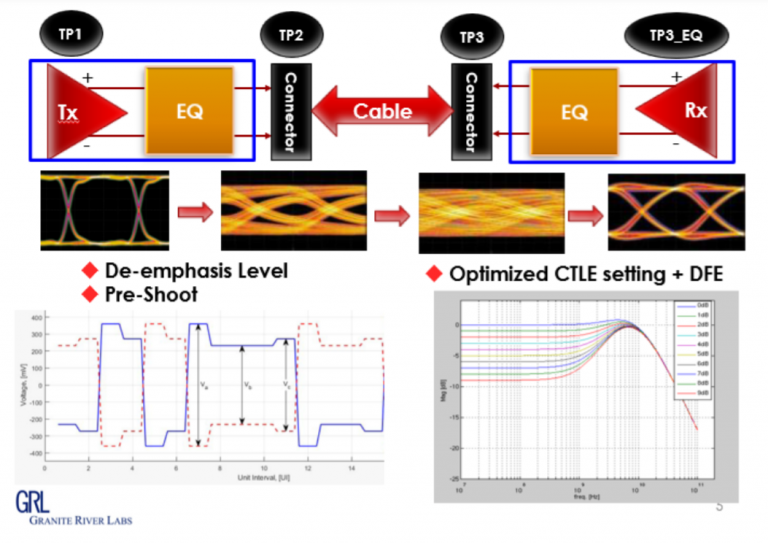In October 2022, VESA released the DisplayPort™ 2.1 (DP 2.1) specification. It introduces the Panel Replay (PR) and Display Stream Compression (DSC) technologies, designed for reducing power consumption in high-bandwidth video transmission, and further enhancing video transmission capabilities respectively.
DSC support in DisplayPort™ 2.1
DP 2.1 products must support DSC, which can only be enabled through support from both the source and sink ends as shown in Figure 1. This is made easier with the release of the complete Compliance Test Specification (CTS) compression technology for DSC in late 2019, which allows DP 2.1 products to fully support DSC. CTS for DSC enables higher resolutions at lower bandwidths by compressing images without affecting visual perception or causing image delay.
.png?width=963615&name=%E5%9C%96%E7%89%872%20(1).png)
Figure 1: DSC support in source and sink devices
Display capability of DisplayPort™ 2.1
The release of DP 2.1 also saw Panel Replay (PR) being introduced, a key feature that significantly reduces power consumption during high-bandwidth DP video transmissions. While manufacturers are not required to support PR, this feature plays an important role in mobile devices such as laptops and smartphones where power consumption and battery life are integral to the user experience.
Unlike the original Panel Self Refresh (PSR) technology, PR can be used beyond just eDP interfaces. As an extension of the early PSR technology, PR is a self-refreshing mechanism that allows the DP Sink to access images through the Remote Frame Buffer (RFB) and stop signal transmission from the Source to enable self-refreshing while achieving power-saving functionality on the Source end.
DP 2.1's display capability can be understood through Table 1. With DSC, DP 1.4 supports a maximum resolution of 8K (7680x4320) with a refresh rate of 60Hz while DP 2.1 with DSC supports up to a maximum resolution of 16K (15360x8460) with a refresh rate of 60Hz.
Table 1: Display capabilities of DP 1.4 and DP 2.1
New physical layer of DisplayPort™ 2.1
The ample bandwidth that DP 2.1 provides makes it fully compatible with the DP alt mode output mode in the USB-C interface. When DP uses the USB-C interface, it can communicate through Power Delivery (PD) and use 2 Lanes DP and 1 Lane USB 3.2 transmission. This creates more development opportunities for AR/VR devices.
The new physical layer introduced in DP 2.1 uses 128b/132b encoding to improve the efficiency of bandwidth usage, which is a significant upgrade from DP 1.4's 8b/10b encoding. However, DP 2.1 uses the same interface architecture as DP 1.4, which includes both 8b/10b encoding for DP 1.4 products and 128b/132b encoding for DP 2.1 products. Figure 2 below illustrates the introduction of DSC in the DP interface architecture.
.png?width=472976&name=%E5%9C%96%E7%89%875%20(2).png)
Figure 2: Introduction of DSC in DP interface architecture
How DisplayPort™ 2.1 transmits video and audio signals
DP 2.1 employs a series of steps to transmit video and audio signals from Source to Sink. Firstly, the Video Stream is encoded using DSC, and the transmission method is determined through the Aux channel. High-Bandwidth Digital Content Protection (HDCP) is then performed to encrypt the audiovisual information. Following that, the encoded video and audio signals are transmitted through 128b/132 encoding to the Sink. Finally, the Sink then decodes the signal in reverse using the same method and outputs the audiovisual data correctly.
Adjustments have been made to the DP 2.1 transmitter equalizer to compensate for signal distortion during high-bandwidth transmissions. By using De-emphasis Level and Pre-shoot while the Receiver uses Continuous Time Linear Equalization (CTLE) and Decision Feedback Equalization (DFE), signal distortion from Source to Sink can be reduced to ensure that the audiovisual data is transmitted completely, as shown in Figure 3.

Figure 3: How DP 2.1 ensures reduces signal distortion
Ultra High Bit Rate in DisplayPort™ 2.1
The DP 2.1 specification uses Ultra High Bit Rate (UHBR), which provides three transmission rate options:
- UHBR10 with a transmission rate of 10Gbps
- UHBR13.5 with a transmission rate of 13.5Gbps
- UHBR20 with a transmission rate of 20Gbps
While UHBR10 is mandatory, manufacturers can choose whether to support the optional UHBR13.5 and UHBR20. Cable types that are suitable for each transmission rate have been defined by VESA in Table 2:
| Version | DP 1.4 | DP 2.1 |
| Supported Data Rates | HBR3 | UHBR13.5 UHBR20 UHBR10 |
| Cable Type | DP40 Cable USB Gen1 Cable |
DP80 Cable |
Table 2: Cable types suitable for UHBR10, UHBR13.5, and UHBR20
Cable support for DisplayPort™ 2.1
With its high bandwidth transmission rate, DP 2.1 has some limitations in terms of cable support. There are two cables type that can support DP 2.1 bandwidth, DP40 cable can support up to UHBR10, and DP80 cable can support up to UHBR13.5 and UHBR20. Also, the DP80 cable is not allowed with long lengths, because it impacts the high bandwidth quality due to the channel loss. This highlights the importance of DSC, which makes efficient use of available bandwidth possible. To expand the usage range of DP 2.0, VESA is actively developing testing specifications for active DP cables to meet market and consumer demands.
Figure 4: DP40 and DP80 cables
DisplayPort™ 2.1 Link Training
DP 2.1 has expanded the use of the Aux channel in the Link Layer to improve compatibility, while also adding register addresses belonging to UHBRx in DisplayPort Configuration Data (DPCD) to enhance the transmission of audiovisual data.
DPCD is only imported at the Sink end, where it is used for DP 2.1 Link Training. Link Training, which sets and manages the conditions of transmitting audiovisual data, determines the product's transmission method and the number of transmission channels, and decides on the EQ parameters to be used for optimal signal transmission and image quality.
The DP 2.1 Link Training process consists of four main steps:
- The Source reads the Sink's DPCD to confirm its capabilities
- DP 2.1 128b/132b transmission mode is enabled
- EQ parameter settings are communicated to confirm transmission quality
- Verify the quality of Link Training using different Training patterns
Figure 5 below illustrates the process of DP 2.1 Link Training.
.png?width=963615&name=%E5%9C%96%E7%89%876%20(1).png)
Figure 5: Process of DP 2.1 Link Training
Differences in standards and specifications in DisplayPort™ 1.4 vs 2.1
Though DP 2.1 CTS has been released since 2021, many manufacturers still prioritize testing for DP 1.2 and DP 1.4 according to observations by GRL experts. This is because many businesses believe that demand for higher resolutions has not yet become widespread, and that most video content is still in 4K. Since DP 1.2 supports 4K resolutions, and DP 1.4 includes DisplayHDR functionality, manufacturers mostly stick to DP 1.4 for DisplayHDR rather than pursuing higher resolutions. Therefore, the adoption of DP 2.1 products is worth monitoring in the coming years.
The differences between DP 1.4 and DP 2.1 according to VESA’s DisplayPort (DP) Standard 2.1¹ are summarized in Table 3. However, discussions about the specifications are still ongoing, so keep in mind that the details outlined below are for reference only. Please refer to the latest content released by VESA for actual specifications.
Figure 3: Summary of differences between DP 1.4 and DP 2.1
Test and comply with VESA DisplayPort 2.1 standards by testing with GRL
The best time to comply with the latest DisplayPort™ 2.1 standards was yesterday. The second best time is now. As the leading contributor to DisplayPort™ compliance test development, GRL has the insider knowledge of working with stakeholders of the DisplayPort™ standard to deliver comprehensive DisplayPort™ testing services that guarantee compliance and reliability. Contact us today to get started on your compliance journey.
References
- VESA DisplayPort (DP) Standard Version 2.1 10 Oct, 2022: https://vesa.org/
Author
Jerry Sung, Song Chaoyu, Technical Manager, GRL Taiwan
GRL global DisplayPort technology development leader, familiar with DisplayPort, HDMI, Thunderbolt, Power Delivery, SD and other application interfaces, as the author and lecturer of GRL technical articles, and has 7 years of testing experience.
Specifications and descriptions in this document are subject to change without notice.



